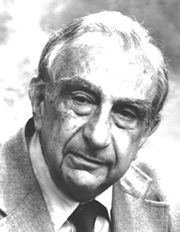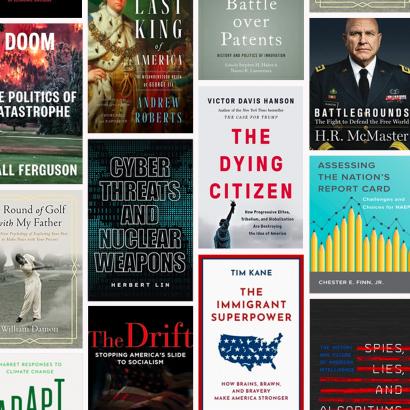- Contemporary
- Security & Defense
- US Defense
- International Affairs
- US Foreign Policy
- History

In December 1945, in my report to the U.S. Navy, I emphasized the need for defense against atomic weapons. During the summer of 1951, I attended a conference in Pasadena, sponsored by the air force, for a few weeks. Among the topics under consideration were low-yield nuclear weapons and strategic defense. The study that eventually came out of the conference recommended tactical nuclear weapons and was against trying to pursue strategic defense.
Even at that early date, the development of intercontinental rockets was clearly on the horizon. The obstacles to developing defense posed by a combination of rockets and nuclear weapons seemed insurmountable. Then, in 1961, following a tour of the Strategic Air Command facilities outside Colorado Springs, General Partridge convinced me that I should at least consider the problem of defense seriously. That in turn led, in 1967, to the Livermore laboratory developing and testing the effectiveness of using nuclear explosives to counter incoming missiles. It was at that time that Governor Ronald Reagan was introduced to the idea of a ballistic missile defense system. (The defensive system, on which both Los Alamos and Livermore had worked, was technically significant and was deployed at an ICBM field, but in 1976 it was decommissioned for lack of funding.)
In 1980, Ronald Reagan ran for president. I campaigned for him, making speeches around the country and serving as the chairman of Hungarian-Americans for Reagan. Martin Anderson, one of my friends at the Hoover Institution, also worked hard on Reagan’s campaign. He was with Reagan during a tour of the same Air Command Center near Colorado Springs that I had visited in 1961. Although its name had changed, its purpose remained the same. (Today the Air Command Center is called the North American Aerospace Defense Command.) It would direct defensive military operations should the United States be attacked. Although almost two decades had passed since my last visit to the center, the possibilities for defense against an incoming missile remained unchanged: there were none.
|
Critics of strategic defense claim that if even a single missile escaped a missile defense system, the damage would be unacceptably great. Such critics seemingly refuse to consider how much more unacceptable the damage would be if any and all attack missiles reached their targets. |
The center was and is impressive. It is isolated inside a very large chamber deep inside a mountain, the entry heavily reinforced and protected. Although the Air Command Center was effectively impervious to attack at the time of my visit, 20 years later it had become wholly vulnerable. The difference lay in the Soviet SS-18 intercontinental ballistic missile (which dwarfed any U.S. missile) that had recently been incorporated in the Soviet arsenal. If a single SS-18 warhead struck within a few hundred yards of the command center, it would completely obliterate it. That fact was one of the first that Reagan learned on his visit.
Anderson reports that, after leaving the Air Command Center, Reagan reflected on the dilemma a president would face in case of a missile attack. His only options would be either to direct our ballistic missiles to be fired in a counterattack or to do nothing except absorb the attack. President Reagan saw both alternatives as bad. "We should have some way of defending ourselves against nuclear missiles," he told Anderson.
President Reagan has been accused of making instantaneous decisions—shooting from the hip, so to speak. His speed in getting off his shot was certainly not in evidence in regard to the subject of strategic defense: sixteen years followed his introduction to the subject at Livermore, and four of them passed after his apparent decision following his tour of the Air Command Center. But on March 23, 1983, President Reagan became a most determined advocate of ballistic missile defense. I do not know how President Reagan arrived at his decision, but I can describe my own involvement in promoting protective defense.
In January 1981, Richard Staar, another of my friends at the Hoover Institution, asked me to read a manuscript he had received from Daniel O. Graham, a recently retired army general. I was pleased to find that General Graham was promoting strategic defense. Graham, however, had linked his plan for strategic defense to a plan to collect solar energy in space, convert it to microwave energy, and beam it back to antennas on earth for conversion into electricity for common use. I doubted the economic feasibility of the plan, and I suspected that such a novel technology would not be readily accepted by the public. (A sizable, vocal group in the Western world has become extremely fearful about the potential effects of new technologies, for example, electric power lines, microwave ovens, and any application of nuclear energy.) Because I considered ballistic missile defense the most important topic, I would have preferred that he present it independently of the exotic commercial energy proposal.
A more important problem lay with Graham’s design of the defense system. The first priority for successful defense is that the defensive system be less expensive to deploy than the means for circumventing or destroying it. Graham suggested space-based platforms containing 40 to 50 defensive units of guided missiles and a few manned space-based units that would coordinate and control the defensive devices housed in the platforms. Such a system of manned platforms would be very expensive to deploy and maintain. Because of the ease of identification of the platforms, it would be much less expensive to shoot down than to deploy and maintain them. So while I agreed with him completely about the need for strategic defense, I very much wished he would be less specific and simply call for using any new technologies that seemed practical.
|
Since the early 1960s, I have believed that peace would be far more secure if we had a ballistic missile defense system. Not only would such a system provide a humane alternative to retaliation, but also, by making the success of a first strike uncertain, it would add to the stability of peace. |
By 1981, the prospects of detecting, discriminating, tracking, and destroying incoming missiles were greatly improved. One promising technology on the horizon involved the use of lasers to detect incoming missiles. (It is very hard to protect radar equipment against the destructive electronic effects of a nuclear explosion. Nuclear fireballs, even at high altitudes, are effectively opaque to most radar signals.) Guided defensive antimissile rockets, popped up from submarines once a missile attack was observed, were also a possibility. New and far more powerful lasers were becoming available that might make it possible to construct a system capable of destroying missiles in the boost phase.
General Graham had been very effective in drawing public attention to strategic defense. He had helped to found an organization, High Frontier, to promote space-based defense and had gathered an impressive list of supporters. Among the founding members of High Frontier were Karl Bendetsen, Joseph Coors, William Wilson, and Jack Hume, four of President Reagan’s close friends and advisers. In the summer of 1981 I joined High Frontier, hoping that as a member I could help the group put together an optimal technical proposal for strategic defense.
In mid-1981, George A. ("Jay") Keyworth was appointed White House science adviser. Not too much later, he organized a White House Science Council and invited me to serve on that board. As of mid-1982, the subject of the new strategic defense technologies had not been discussed.
That is not to suggest that Jay was not an excellent science adviser. I had suggested him as a candidate when Martin Anderson, who was then the director of domestic policy, asked me for a recommendation. I had become acquainted with Jay, a young scientist at Los Alamos, while I was consulting at the laboratory during the 1970s. I was much impressed by the combination of enthusiasm and sound scientific instincts that he displayed.
When my longtime friend Harold Agnew retired as director of Los Alamos about 1980, I asked Greg Canavan to recommend Keyworth to the search committee. But Greg misunderstood my Hungarian-style pronunciation. He thought I said Gibberth, and while he diligently sought such a person at Los Alamos, he failed to find him, so nothing came of my suggestion. The misunderstanding proved fortuitous. Having not been chosen as director, Keyworth was available for the position of presidential science adviser.
In the fall of 1982, I asked Jay Keyworth to establish a study group within the White House Science Council to review the technical basis for strategic defense. Jay agreed and asked Sol Buchsbaum to head the group, which included me as one of about six members.
We worked diligently throughout the fall of 1982, listening to detailed presentations in government and industrial laboratories all over the country. Our final report, which was issued in January 1983, assessed the technical prospects for strategic defense favorably. The report, I believe, was then provided to the president.
Later that month, I was in Washington, D.C., for a meeting with Secretary of Energy Donald Hodel and ran into an acquaintance, Admiral James D. Watkins, who invited me to lunch. At that time Admiral Watkins was chief of naval operations, the senior officer of the U.S. Navy. We discussed research on an X-ray laser, which was new and had had little exposure even in high security circles. I later learned that the admiral did not like the nuclear nature of the laser but was very impressed that I was optimistic about strategic defense.
At that time, the Joint Chiefs of Staff were attempting to deal with the problem of increased vulnerability of U.S. silo-based missiles (from the new Soviet missile SS-18). The solution was not readily apparent. The best and most widely discussed proposal (the MX system) called for removing the missiles from their silos and moving them about on a rail system, a process that would make them more difficult to target. However, the MX system had not gained much support. After our luncheon, Admiral Watkins, who had been hearing recommendations to consider strategic defense from others as well, convinced the Joint Chiefs to support a long-term shift in policy, pointing out that strategic defense was both militarily and morally sound.
The recommendation of the Joint Chiefs of Staff was presented to the president in early February. I saw Watkins about that time at a tribute to Admiral Rickover, and he spoke with me briefly, telling me that he thought something good might come of our talk.
On March 20, 1983, I received a call from the White House: Would I please attend a dinner with the president on the evening of March 23? I canceled my appointments, scrambled to get flight reservations, and did indeed arrive on time at the White House. That evening President Reagan made an eloquent plea for strategic defense:
I have become more and more deeply convinced that the human spirit must be capable of rising above dealing with other nations and human beings by threatening their existence. . . .
Wouldn’t it be better to save lives than to avenge them? Are we not capable of demonstrating our peaceful intention by applying all our abilities and our ingenuity to achieving a truly lasting stability?
I think we are. Indeed, we must. . . . Let me share with you a vision of the future which offers hope. It is that we embrace a program to counter the awesome Soviet missile threat with measures that are defensive. . . . What if free people could live secure in the knowledge that their security did not rest upon the threat of instant U.S. retaliation to deter a Soviet attack, that we could intercept and destroy ballistic missiles before they reached our own soil or that of our allies?
I know this is a formidable task, one that may not be accomplished before the end of the century. Yet, current technology has attained a level of sophistication where it is reasonable for us to begin this effort. . . .
I call upon the scientific community of our country, those who gave us nuclear weapons, to turn their great talents now to the cause of mankind and world peace, to give us the means of rendering these nuclear weapons impotent and obsolete.
Those wonderful words moved me deeply. For more than 20 years, I had believed that peace would be far more secure if we had a ballistic missile defense system. Not only would such a system provide a humane alternative to retaliation, but also, by making the success of a first strike uncertain, it would add to the stability of peace.
Support for SDI in the United States was less than wholehearted. I believe that part of the problem was lack of understanding of what constitutes effective ballistic missile defense. Immediately after the president’s speech, Secretary of State George Shultz, with whom I was acquainted, asked me, "Can this system be 100 percent effective?" My response was, "Against the largest attack that the Soviets can mount? Probably not."
However, the question remains: Is it better to be able to destroy 90 to 95 percent of the missiles in a massive attack or to have no defense against missiles? Critics of strategic defense claim that if even a single missile escaped the defensive system, the damage would be unacceptably great. Such critics seemingly refuse to consider how much more unacceptable the damage would be if any and all attack missiles reached their targets.
In June 1984, 27 months after work on strategic defense was announced, I reported to President Reagan that we had progress on several technologies but no overall approach to a strategic defense system. By the fall of 1986, a group of friendly congressmen and political advisers, including Jack Kemp, Rudy Boschwitz, Jack Courter, and Eugene Rostow, told us that even though SDI was little more than three years old, its political future was in doubt: progress on strategic defense was being made too slowly.
We then jointly wrote a letter to the president, asking him to continue his support, but we knew the pressures on him to abandon SDI during the upcoming summit in Reykjavik, Iceland, would probably be particularly great. (President Reagan had staunchly defended SDI at the first summit meeting with the Soviets, which was held in Geneva.)
The Soviet concessions at Reykjavik were attractive. Little progress was then apparent in the SDI program, but President Reagan was firmly committed to providing strategic defense. It was his responsibility as president, he told Gorbachev, to protect and defend the American people. That meant continuing to work on strategic defense. (Many, including Gorbachev, now see President Reagan’s firm support of SDI as pivotal in the eventual collapse of the Soviet Union.)
|
Today the United States—and every other country—is as vulnerable to missile attack as it was when I began concentrating on the problem in 1961. The risk of missile attack has not abated. Indeed, the availability of missiles has become more widespread, as has the supply of weapons-grade nuclear materials. |
In November 1986, Lowell Wood, Greg Canavan, and I had our monthly informal meeting to debate the various ways of providing defense. At our gathering, Greg proposed that we take a closer look at the kinetic energy system. That project, which had acquired the nickname Smart Rocks, called for predeployed arrays of explosive devices that would scatter projectiles into the path of a rising attack missile. I objected that we were looking at predeployed space stations, which are cheaper to destroy than to deploy. Greg countered that the satellites could be made very small and therefore would be hard to find. He added that what he had in mind was a satellite with its own propulsion, sensing system, and decoys. The components of such a satellite—microprocessors and rockets to power the device—were small, light, and increasingly inexpensive. Furthermore, a constellation of a few thousand such devices could defend the northern hemisphere.
By the end of that breakfast, Lowell seemed unusually interested. He went back to Livermore and redoubled his efforts. The design Lowell and his colleagues developed during the next 10 months, called Brilliant Pebbles, was a satellite that would measure less than 40 inches and weigh about 120 pounds. At last, we had a plan for a cost-effective, thorough-going defense system that could indeed be in place by the mid-1990s. Such a system could provide protection for all nations in the northern hemisphere against both short- and long-range missiles. A safer, more stable peace appeared within reach.
Vice President Bush was elected president in 1988 and assumed office in January 1989. President Bush, like President Reagan, had an excellent grasp of the importance of strategic defense. On February 7, 1990, he came to the Lawrence Livermore National Laboratory to review the Brilliant Pebbles program, thus becoming the first sitting president to visit a national laboratory. In March 1992, the Pentagon formally adopted the Brilliant Pebbles system and planned to begin its deployment in 1996. The estimated cost of a sufficient number of Brilliant Pebbles to protect the northern hemisphere was $2 billion, with an additional cost of $1 billion to establish them in their orbits. (The Pentagon also noted that there would be $8 billion in other, largely administrative, costs to develop and deploy Brilliant Pebbles, operate the system for 10 years following its deployment, and then decommission it.)
President Bush proved to be a thoughtful and courageous supporter of strategic defense throughout his term of office. However, following his defeat in the 1992 elections, the strategic defense program was sharply scaled back, effectively terminating much of it.
As I write this memoir in 2000, the United States—and every other country—is as vulnerable to missile attack as it was when I began concentrating on the problem in 1961. The risk of missile attack has not abated. The availability of missiles has become more widespread, as has the supply of weapons-grade nuclear materials. The lack of strategic defense gives small powers a chance to do great damage.
The two world wars of the twentieth century have demonstrated the importance of the role that the United States plays in preserving freedom. Today, the need for international stability is greater than ever.
To turn the program of strategic defense, technically and politically, into a reality will require more of the sort of spirited leadership exemplified by President Reagan. In my opinion, the president of the United States has two important roles: The first is to respond to the will of the people. That role is generally fulfilled. The second role is to inform and lead the American people in the direction that will help minimize the dangers of a rapidly changing world. Such a leader is a national treasure.







